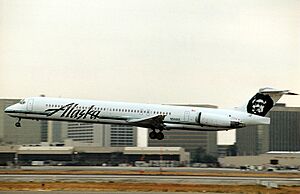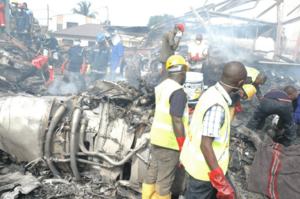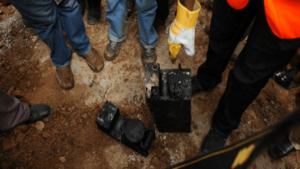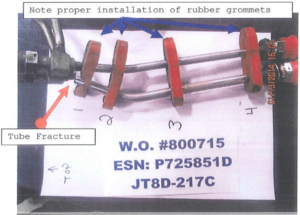Dana Air Flight 0992 facts for kids

5N-RAM, the aircraft involved in the accident, at Lagos Airport in 2009
|
|
| Accident summary | |
|---|---|
| Date | 3 June 2012 |
| Summary | Crashed on landing following engine failure and pilot error |
| Place | Iju-Ishaga, near Murtala Muhammed International Airport, Lagos, Nigeria 06°40′19″N 03°18′50″E / 6.67194°N 3.31389°E |
| Passengers | 147 |
| Crew | 6 |
| Fatalities | 153 |
| Survivors | 0 |
| Aircraft type | McDonnell Douglas MD-83 |
| Airline/user | Dana Air |
| Registration | 5N-RAM |
| Flew from | Nnamdi Azikiwe International Airport, Abuja, Nigeria |
| Flying to | Murtala Muhammed International Airport, Lagos, Nigeria |
Dana Air Flight 0992 was a passenger flight in Nigeria. On June 3, 2012, a McDonnell Douglas MD-83 plane was flying from Abuja to Lagos. During its approach to Lagos, both of its engines stopped working. The plane crashed into buildings, killing all 153 people on board. Six people on the ground also died.
This accident, with 159 deaths, is the deadliest commercial plane crash in Nigeria since 1973. The Nigerian Accident Investigation Bureau (AIB) investigated the crash. They found that both engines lost power because their fuel lines were wrongly put together. This stopped fuel from reaching the engines.
The pilots did not declare an emergency right away. They waited until the second engine failed during the final approach. The AIB said that the pilots' lack of awareness and poor decisions caused the plane to crash. This accident led to big changes in Nigeria's aviation safety rules. Since then, Nigeria's air safety has gotten much better.
Contents
The Aircraft Involved

The plane was a McDonnell Douglas MD-83. It had two engines and was registered in Nigeria as 5N-RAM. The plane was built in 1990. It first flew for Alaska Airlines until 2008.
Then, it was sold to another airline before Dana Air bought it in February 2009. The plane had flown for over 60,800 hours. Its engines had flown for over 55,300 and 26,000 hours. The last time the plane was checked for maintenance was on June 2, 2012. This was just one day before the accident.
Who Was On Board?
Passengers and Crew
| Nationality | Passengers | Crew | Ground | Total |
|---|---|---|---|---|
| Nigeria | 134 | 3 | 6 | 143 |
| China | 6 | 0 | 0 | 6 |
| United States | 2 | 1 | 0 | 3 |
| India | 1 | 1 | 0 | 2 |
| Benin | 1 | 0 | 0 | 1 |
| Canada | 1 | 0 | 0 | 1 |
| France | 1 | 0 | 0 | 1 |
| Germany | 1 | 0 | 0 | 1 |
| Indonesia | 0 | 1 | 0 | 1 |
| Lebanon | 1 | 0 | 0 | 1 |
| Total | 147 | 6 | 6 | 159 |
Flight 0992 had 147 passengers. This included 15 people from other countries. There were six Chinese, three Americans, and two Indians. Also, one person each from Benin, Canada, Germany, France, and Lebanon.
Some important people were on board. These included Celestine Onwuliri, husband of a Nigerian Foreign Minister. Also, Ehime Aikhomu, son of a former Nigerian Vice President. Ibrahim Damcida, a former government official, and Levi Chibuike Ajuonuma, a company spokesperson, were also on the flight. Shehu Sa’ad, a bank director, was also a passenger. News reports said several military officials were on the plane too.
The plane had 6 crew members. This included the American captain, an Indian First Officer, an Indonesian flight engineer, and three Nigerian flight attendants.
The captain was 55-year-old Peter Waxtan. He had flown planes for 18,116 hours. Of these, 7,466 hours were on the MD-83. He used to be a captain for Spirit Airlines. Dana Air hired him on March 14, 2012.
The first officer was Mahendra Singh Rathore, 34 years old. He had flown for 1,143 hours, with 808 hours on the MD-83. He worked for Dana Air before as a director of cabin service. He became a pilot in January 2011.
What Happened During the Flight?
Flight 0992 left Abuja at 2:58 PM local time. There were 153 people on board and 26,000 pounds of fuel. The weather was good. Captain Peter Waxtan and First Officer Mahendra Singh Rathore were flying the plane. Rathore was the one actively flying. This was a busy flight, and the plane was on its second trip from Abuja that day.
First Engine Problem
About 17 minutes after taking off, the crew noticed a problem with the left engine. It wasn't producing enough power, even though the pilots set the throttle high. First Officer Rathore asked Captain Waxtan if they should call the engineer. But Waxtan said no. He thought they could fix it themselves.
Captain Waxtan then wondered if a ground crew member had done something to the plane. He thought "the guy" was angry at them. Before the flight, the pilots had refused to let ground engineers use a certain door for passengers.
Despite the problem, the crew decided to keep flying to Lagos. They didn't think it was serious enough to land at the nearest airport. The left engine was barely working, but they didn't tell Lagos Air Traffic Control (ATC) about it. They also didn't check the emergency list for an engine problem.
As the plane was cleared to descend, Captain Waxtan told First Officer Rathore to descend faster. Rathore disagreed, saying a slower descent was better. Flight 0992 was then cleared to approach Runway 18L in Lagos. Still, the crew didn't make an emergency call or mention the engine problem. Captain Waxtan took over flying the plane. He thought the right engine was still working, so it was safe to continue. He said, "Okay, this one is good for us so far."
Second Engine Problem
As the plane got closer to Lagos, the crew became worried. They were getting many directions from Lagos ATC. They looked through checklists for landing. But they didn't read the checklist for landing with only one engine. The plane was a bit too high. Captain Waxtan decided to descend faster. He asked First Officer Rathore to set the flaps to 15 for landing. This would help the plane fly with less drag. But they still needed more power for the final approach. The crew was in a tough spot.
Captain Waxtan tried to slow the descent by giving more power to the right engine. But the right engine didn't respond. Both engines had now completely failed to produce power. Realizing how serious it was, the crew finally declared an emergency. They were about 11 miles (18 km) from the airport.
| 15:42:01 | Flight 0992 | Lagos Tower, Danaco zero niner niner two. |
| 15:42:05 | Lagos ATC | Danaco zero niner niner two this is Lagos.. uh.. Radar. Go. |
| 15:42:10 | Flight 0992 | Mayday Mayday Mayday, Danaco zero niner niner two, Five November Romeo Alpha Mike, dual engine failure. |
| 15:42:16 | Lagos ATC | Danaco zero niner niner two, how do you read? |
| 15:42:18 | Flight 0992 | I read you five by five, dual engine failure, negative response from throttle, requesting direct approach. Danaco zero niner niner two. |
| 15:42:27 | Lagos ATC | position is one zero miles to touchdown one eight right, contact tower now one one eight one. |
| 15:42:32 | Flight 0992 | one one eight one good day. |
Even with the emergency, the crew still didn't read the emergency checklist. They tried to contact the control tower for landing directions but couldn't. The flaps were set to 28. Captain Waxtan asked the flight attendant to get ready for landing. At this point, it seemed like they still had some control.
A few minutes later, an "altitude" warning sounded. Captain Waxtan said he saw the runway. The flaps were pulled up, and the landing gears were selected up. Since both engines had no power, Captain Waxtan said, "we just lost everything, we lost an engine, I lost both engines." For the next 25 seconds, he asked for anything to get power back. With no engine power, the plane kept losing speed and height.
The Crash
The plane lost power and fell closer to the ground. The crew tried to avoid buildings by adjusting the plane's trim. But they couldn't stop the descent. The plane lost height very fast, and the altitude warning sounded until the end of the recording.
The MD-83 crashed in a crowded area called Iju-Ishaga, near the airport. It first hit a two-story building with its right wing. Then it hit trees and three more buildings. The plane exploded and caught fire. The fire spread through the neighborhood. One building that was hit was unfinished and stored flammable liquids, which made the fire worse. Many people first thought the explosion was an attack by a terrorist group.
The crash site was very chaotic. Thousands of people tried to get close. Crowds tried to bring water hoses. Soldiers tried to push people back. People threw stones at the soldiers. There was not enough water for firefighting for hours because of a shortage of fire trucks. People tried to fight the fire by hand with buckets of water. Water trucks from nearby construction sites had trouble reaching the site because the roads were narrow.
When the authorities put out the flames, the fire had destroyed almost all of the plane. Only the tail remained. No one on the plane survived. All 153 passengers and crew died. At least 6 people on the ground were also killed. Later, experts found that 27 people on the plane, sitting at the back, had survived the initial crash. Some residents said they tried to escape the burning plane, and locals tried to open emergency exits. But they died from smoke and later explosions.
The Investigation Begins
Because the plane was made in America, the United States National Transportation Safety Board (NTSB) helped with the investigation. Other groups like the Federal Aviation Administration (FAA), Boeing, and Pratt & Whitney Canada also sent experts.
Both the cockpit voice recorder (CVR) and flight data recorder (FDR) were found on June 4. They were burned. The FDR was so damaged that its digital tape melted, so no information could be recovered. But the CVR's memory card was still good, even though its case was badly burned. About 31 minutes of conversations were recovered from the CVR.
One day after the crash, a Nigerian aviation official said Dana Air knew the plane was not safe. She claimed the owner knew it had problems but still let it fly. Other officials agreed, saying Dana Air should be charged with murder. However, the agency later denied these claims.
Why Did the Engines Fail?
The crew reported that both engines failed just before the crash. Checks at the crash site showed that the engines were not producing much power when the plane hit the ground. To find out why, both engines were sent to the United States for a detailed check.
During the check, investigators found broken parts in the fuel lines of the left engine. The fuel lines were fractured. The fuel manifolds (parts that distribute fuel) were bent and twisted. On the right engine, the fuel manifold had collapsed and was fractured. The fuel lines of both engines were also broken where they connected.
The AIB wanted to look closer at the engines. Only the left engine was sent back to Lagos. The right engine was not returned for unknown reasons. Tests on the left engine showed that its manifolds were stressed too much. But there was no proof that the breaks happened before the crash. Without the right engine, the team looked at the fuel pumps instead.
Investigators thought there might be germ growth in the fuel. This could happen if the fuel was stored in the sun, making it hot. High humidity in Nigeria's climate could help fungi grow. This could damage fuel tanks and block fuel pipes. However, initial fuel tests did not find any contamination. Still, investigators told Dana Air to check for fuel contamination and use special chemicals to treat it.
Investigators also looked into Dana Air's "peculiar fuel management." They found that on MD-83 flights, the center fuel tank was almost empty when landing. But the fuel tanks in the wings were full and not used. Because of this, investigators told Dana Air to keep at least 2,000 pounds of fuel in the center tank when landing. There was no proof that running out of fuel caused the crash. The recordings showed the plane had 26,000 pounds of fuel. But the investigation continued. Later, they found a big clue.
A Big Clue
On October 6, 2013, another Dana Air MD-83 flight (Flight 0348) had engine problems. This plane was flying from Port Harcourt to Lagos. The crew reported the exact same problem as Flight 0992: an engine that didn't respond to power commands. The pilot had noticed the problem earlier. He saw the engine took about 30 seconds to speed up from idle to 60%, instead of the usual 6 seconds.
Unlike Flight 0992, the crew of Flight 0348 told ATC about the problem and declared an emergency. The plane landed safely. The engine was sent for a detailed check. Both 5N-RAM (the crashed plane) and 5N-SAI (Flight 0348) had their engines checked by the same company. So, the engine from Flight 0348 was sent to Miami for more checks.
The check showed that the engine from Flight 0348 had the same damage as the engines from Flight 0992. The right engine had broken fuel manifolds. The fuel tube had separated from its nozzle. Fuel was leaking, and the engine didn't respond to power changes.
The AIB found that the fuel manifold was installed incorrectly by the company. The protective covers of the tube were put on wrong. This caused the fuel lines to break.
Problems with Maintenance
The engine maker, Pratt & Whitney Canada, knew about possible fuel manifold breaks. These breaks could cause fuel leaks and big problems. In 2001, an engine fire happened because of this. So, Pratt & Whitney issued a special notice to fix the problem. In October 2003, they told all airlines to replace or change the fuel manifold with a stronger material. This new material would prevent breaks.
The right engine of the crashed plane was updated in 2005. At that time, it was flying for Alaska Airlines. But the left engine was not updated. It was sold to Dana Air as it was. Both engines were later checked by the company in 2011. But these checks were not done according to the special notice. The company also installed the manifold incorrectly. This put more stress on the fuel tubes.
The installation of a part called the fairing was also wrong. It was not sealed tightly. This loose fairing was open to the side. When the engine burned fuel, it created hot air. The loose fairing caught this hot air like a sail, creating drag. This pulled on the fuel inlet tube. Because of the wrong installation, the old tube material, and hot air, the fuel inlet tube cracked. The fuel lines inside collapsed, reducing fuel flow. This caused the engine to speed up slowly. Investigators couldn't explain why the right engine had the same problem, even though it was supposed to be fixed.
The pilot of Flight 0348 said other Dana Air planes had slow engine acceleration. All these planes had engines checked by the same company. This led the Nigerian Civil Aviation Authority (NCAA) to order all planes with engines from that company to be checked by an approved shop. These planes could not fly until fixed.
Flight simulations were done to see if the crash could have been avoided. All simulations showed that the crash was not unavoidable. If the crew had made the right decisions during the emergency, the crash could have been prevented. Even if a crash happened, fewer people might have died. Even with both engines failing, the plane could have been landed safely.
Poor Decisions by Pilots
The actions of the crew greatly affected the crash. The crew did not follow the correct steps for an engine failure. They did not use the emergency checklist. If they had, they would have landed the plane at the nearest airport. There were three airports nearby: Ilorin, Ibadan, and Abuja. Ibadan was even listed as an official alternative. But the crew ignored them.
The first engine failed just 17 minutes into the flight. The flight to Lagos was about an hour long. So, the crew had plenty of time to declare an emergency. But they waited until the second engine failed. They didn't tell ATC about the first engine problem. Captain Waxtan might have been afraid of being investigated by Nigerian authorities. In the cockpit recording, he said if they declared an emergency, they would be investigated. He also said the plane "could not quit on them."
Recordings also showed that Captain Waxtan was much more experienced than First Officer Rathore. This made Rathore less confident. For example, Rathore suggested they descend slower, but Waxtan overruled him. The AIB said if they had stayed at a higher altitude, as Rathore suggested, they would have had a better chance to reach Lagos.
Because they didn't delay the descent, the plane got too low too fast. The crew was in a difficult situation. They needed more power for the final approach, but the plane was losing speed. Captain Waxtan sounded panicked, saying he "didn't want to stall the plane." Since they didn't read the checklists, they set up the plane incorrectly. They extended the landing gear and flaps, which made the plane lose speed even faster. They realized the speed was dropping, but by then, the plane was too low.
Captain Waxtan and Dana Air's Culture
Both pilots were from other countries. Their hiring process was checked. While there were no special notes about First Officer Rathore, documents showed Captain Waxtan's flying license was suspended in the United States in 2009. This was for problems with a hard landing and not reporting a plane repair. The license given to him by the Nigerian Civil Aviation Authority (NCAA) was stamped but not signed by any official.
The investigation also found that Waxtan's instructor had told him to improve his flying. But there were no documents to show he did. There was also no proof that Captain Waxtan followed all the hiring rules, like interviews and background checks. All this suggested that Dana Air hired Waxtan very quickly. His performance reviews also showed he was quickly trained to fly the MD-83, even with many notes about his poor performance.
Findings about Captain Waxtan's hiring led to more discoveries about Dana Air's company culture. Dana Air's Quality Department was never involved in hiring foreign pilots. Interviews with former pilots showed problems with how Dana Air maintained its planes. Pilots often did not write down plane problems in the official logbook. Some senior pilots did this. Most of the pilots interviewed had either been fired or quit because of these issues.
The Nigerian Civil Aviation Authority (NCAA) is supposed to watch over all airlines in Nigeria. The problems found showed that there was not enough oversight. The AIB told the NCAA to improve its safety checks on airlines.
Final Report Findings
On March 13, 2017, the Nigerian AIB released its final report. It was 210 pages long.
The report listed the main reasons for the crash:
- Engine number one lost power 17 minutes into the flight. Then, during the final approach, engine number two also lost power and didn't respond when the pilots asked for more power.
- The crew did not use the checklist. They also didn't understand how serious the engine problem was. They failed to land at the nearest suitable airport.
- The pilots lacked awareness of the situation, made poor decisions, and showed poor flying skills.
The AIB made several recommendations, mainly to Dana Air. Nigeria's NCAA was told to improve its oversight, especially on maintenance. The FAA was asked to make sure Pratt & Whitney changed its service bulletin to be mandatory. They also asked for the engine part to be redesigned so it couldn't be installed incorrectly.
Aftermath
On June 3, 2013, the Lagos government put up a memorial for the victims of Flight 0992.
See also
 In Spanish: Vuelo 992 de Dana Air para niños
In Spanish: Vuelo 992 de Dana Air para niños
- Midwest Express Airlines Flight 105, where pilots didn't declare an emergency after engine failure because of airline rules.
- Aerosvit Flight 241, where pilots refused to declare an emergency even though they were lost.





